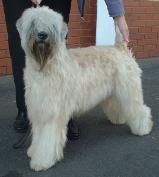
This is a placeholder text
Group text
by sueincc on 24 January 2009 - 16:01
The really great trainers that I see have so many different tools, from bribery to motivational to compulsion to force, everything in between and probably some well developed secrets too in their tool boxes, they are open to all methods, and they can figure out quickly what will work and what will not work depending on the dog at hand.
To me, this is a big part of what separates the truly great trainers from the rest of us poor slobs.
by Dawn G. Bonome on 24 January 2009 - 17:01
My dog loves his Kong toy, and is also motivated by food.
Dawn
by darylehret on 25 January 2009 - 05:01
Motivation by verbal praise has also become important for me, and the bond with the dog is crucial in that respect. Your vocal tonality, pitch, tempo, etc. then becomes a powerful tool in its own right. Body language and gestures are also important communication channels receptive to the tractable dog.
Using all of these; food, toy, voice, gestures in the way that best motivates the dog, and gets you the response you want, is what training the handler is all about, and the offers the most flexibility in initiating each excercise. Marking and timing of the reward is also significant, and the dog's flexibility to work either with motivation, and/or accompanied with compulsion.
As far as drive "building" goes, I'm a non-believer. A low drive dog can be made to store that drive, but runs out of gas too quickly to be worth the effort. Not something to breed on, IMO. Building a tractable/biddable relationship has more permanence.
by jletcher18 on 25 January 2009 - 05:01
i say use whatever toy the dog has the most drive or want for. note that i dont let my dogs play with said toy any other time but training. if the dog hangs out with the toy all the time, then what motivation is there to play with it when you want them too?
john
by darylehret on 25 January 2009 - 06:01
I don't at all disagree about keeping the toy from them when not training, but I don't necessarily follow that advice. I don't leave him with a tug though, because he'd shred it.
by Rezkat5 on 25 January 2009 - 06:01
I've found with one of my own dog's that the obedience work is much better focused with food vs. using a toy as a primary reinforcer. The toy still comes out as in between she enjoys the "fight" of the toy, just like the sleeve. However as a primary motivator/reinforcer, she prefers food. The toy will motivate, just really not as much as the food. If that makes any sense. So we use both.....
She too likes the tennis balls thrown by the chuck it toy. Most of her "running" exercise comes during herding. But even if she hasn't gotten to herding, she's quite content to hang in the house.
by darylehret on 25 January 2009 - 06:01
by macawpower58 on 25 January 2009 - 07:01
Would you please explain your way of thinking?
Thankyou
Becky
by sueincc on 25 January 2009 - 18:01
by darylehret on 25 January 2009 - 20:01
One thing I realized early on, was that capping drive is a helluva lot easier than building it. Now, this is of course going to largely depend on the dog you have. You have to do what you have to do with some particular dogs, and it's these that bring into question their use for breeding or at least, suitability for sport. But desire to work is an aspect of temperament, and given that the dog has the proper natural level of drive, hormone levels, metabolism, and all else inside the realm of their hereditary and biological influence, then all you need to focus on is your ability to properly motivate the dog to your instruction, anytime, anyplace, and without necessary preparation. When the bond/relationship is strong, "you" are the motivation, moreso than any toy or food. And that will be one very special dog to you.
Contact information Disclaimer Privacy Statement Copyright Information Terms of Service Cookie policy ↑ Back to top




